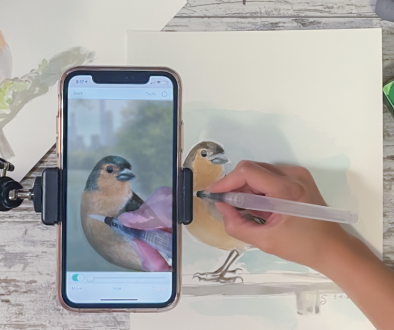Master of the Month: Jean-Auguste-Dominique Ingres
One of the richest sources of inspiration is the deep well of art that has been created throughout history. In recognition of how much these works have to teach, we at Da Vinci Eye are proud to present the Master of the Month series of events. Each month, we will feature an artist, style, or subject from which to draw inspiration and gain insight. This month, use Da Vinci Eye to explore the phenomenal work of Ingres.
Master of the Month: Ingres
Jean-Auguste-Dominique Ingres may not be a household name to many, but this 19th-century master has works featured in the Louvre, and has inspired generations of artists since he began earning recognition at the turn of the 1800s. While much of his work focuses on history, religion, and mythology–a connection to Raphael and other Renaissance painters he admired–Ingres displayed a preternatural talent for portraiture, capturing the form of his subjects with an accuracy that continues to astonish.
At a time when photography was still a novelty, Ingres proved himself adept in photorealism. Individual details are fascinating in their exactness; together, they form a captivating image that carries the spirit of its subject. There is true mastery in his portraits, brought to life through carefully constructed line and shade.
The Hockney–Falco Thesis
English artist David Hockney, in his 2001 book Secret Knowledge: Rediscovering the Lost Techniques of the Old Masters, recounts being struck by the realism Ingres managed to capture in his portraits, some of which were little larger than a pack of playing cards. But this particular visit revealed something subtler: confidence. Despite the diminutive size and apparent swiftness of the strokes, Hockney sensed none of the searching characteristic of sketches. Rather, Ingres seemed to convincingly capture the folds of clothing and the delicate placement of fingers in precise, economical, and certain lines.
Alongside physicist Charles Falco, Hockney concluded that artists such as Caravaggio and Vermeer likely used optical tools like the camera lucida and camera obscura to aid in their work. These technologies helped artists capture the world with unprecedented realism, hundreds of years before photographs monopolized the role. In fact, Hockney asserted that a sudden and widespread spike in naturalistic painting aligned with this trend. A larger movement toward tracing projected images was hiding in the details of hundreds of works, obscured by the secrecy of competing artists and by the intervening centuries.
If Hockney and Falco are correct, the skill of these artists extends to include the ability to use these devices. Understandably, some critics felt that these claims devalued the accomplishments of these masters. To see this as cheating, however, is to discount the speed, technique, perception, and judgment required to turn vision into something concrete. Hockney is fond of pointing out that optics alone don’t leave marks. It’s the action of the artist that transforms what is visible for a moment into something more permanent and transferable to others.
Ingres as an Ambassador
Any number of artists’ works could have alerted Hockney to the presence of optics underlying this photorealist movement. Jan van Eyck, Lorenzo Lotto, perhaps even Rembrandt leave hints of optical aids. That it was Ingres whose portraits would intrigue Hockney and spark this theory seems fitting. Photography would, in Ingres’s lifetime, render the mastery of such tools as the cameras obscura and lucida somewhat obsolete. The impact of his portraits, still so striking two centuries later, speaks to his prodigious talent.
If the purpose of art is, among other things, to capture the world, putting to paper or canvas some version of what one sees, then the tools used are secondary to the image that is created. They become just another in a collection of skill, techniques, and knowledge, demanding rather than removing thought. Simply seeing is not enough; optics do not make marks. Rather, it is about reading the reflection, teasing apart the elements that inform us of the collective whole. The artist must make judgments, deciding what to include and what to omit. Tracing is, unfortunately for some, neither simple nor straightforward. Certainly, it does not replace work.
Ingres is then a wonderful representative. His work is stunning in its accuracy and spirit, so much so that it took nearly 200 years to see beyond it. In light of the theories put forth by Hockney and Falco, Ingres represents a unique mastery. Tracing may have provided proportion and scale, but his hand guided the rest.

Modern photography has suspended reality, rendering speed obsolete and accuracy a foregone conclusion. But that convenience comes at the cost of a knowledge that is now being rediscovered. To see one’s hand move along an image is a one-of-a-kind experience, and offers its own lessons.
We honor Ingres for his many achievements, his immense talent, and his incredible body of work. Explore his portraits, admire his technique, and discover what there is to learn.








